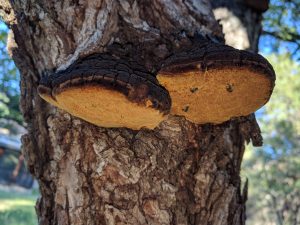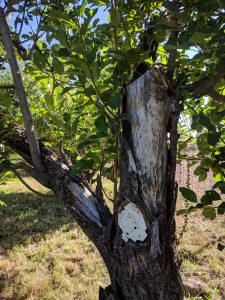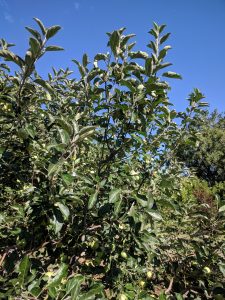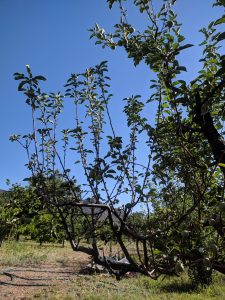Summer is a time of bounty in the home garden. During June, July and August the majority of small fruits ripen on home orchard trees. Plant health care is important to consider in advance of summer bounty. Careful dormant season pruning, dormant sprays, mulching and care helped to produce a nice harvest. As the fruit comes off the tree, some summertime options are available. This is a time when some limited summer pruning can be done to manage the physiology and growth of many fruit trees. Even some citrus will benefit from careful summer pruning.

One obvious reason to prune in summer is to repair broken and remove dead branches that may have occurred from excess fruit weight or other injuries. Breakage is common in peach, plum and apples if fruit loads are not thinned earlier in the season. Cut the broken branch from the stem it attaches to with an angled cut that leaves the branch collar intact. Do not cut branches flush with the stem they were attached to. Many years ago the myth of flush cuts for shade trees was found to permanently damage trees, but flush cuts are often still practiced on fruit bearing trees. Flush cuts allow decay organisms to enter trees leading to heart rot and other kinds of wood decay.

Another myth that persists in home fruit orchards is painting wounds with a ‘sealant’ or ‘protestant’. There is no reason to paint cuts. They do not limit the progress of decay or prevent decay from forming behind the paint. Pruning paints do not promote “healing” or callus formation to close the wound. There is some thinking that pruning paints may even accelerate the process of decay formation. So throw away the black tar, it has no practical purpose in support of pruning.

While pruning paints are no longer used, paint has other functions that can be helpful. If a large branch was removed from a tree, sometimes the remaining branches may require protection from sunlight. Apples and other thin-barked trees (citrus, cherries, etc.) are very susceptible to sunburn. If branches that were previously shaded are suddenly exposed to high light levels, the bark can be destroyed leading to sunburn cankers and entry of disease-causing fungi such as Botryosphaeria spp. If repair pruning exposes a large gap in the canopy, it is appropriate to apply white wash or diluted white latex paint to exposed branches in order to protect them from bright sunlight. The most severe damage occurs on southern and west facing branches. Sunburn is one of the leading causes of abiotic damage and a predisposing factor for disease such as stem and branch cankers in apples.
Fireblight is another common disease on pears and apples and develops after bloom. Pruning out fireblight affected twigs helps to arrest disease progress. Finally, bacterial canker can be devastating to Prunus (plum, cherry, peach, nectarine and almond) in parts of the country with warm summer rains. Immediate removal of bacterial canker affected branches is necessary to prevent permanent damage to the tree. Tools used to remove cankered branches should be sanitized by flame (torch) or with disinfectants. Canker diseases are active in the warm summer growing season. Cankers can be caused by bacteria or fungi and should be dealt with as soon as symptoms are noticed. The earliest symptom of an active canker is slowed growth relative to other branches on the tree. Slowed growth results in smaller leaves and fruit and fewer leaves. Affected branches seem more open and just look “weaker” than their healthy counterparts. Slowed growth is often followed by wilt, leaf drop and eventually necrosis or death of the branch. It is best to remove diseased branches early before the organism spreads to the main stem. Since symptoms occur when leaves are on, summer pruning is the best approach to remove cankered branches. Regardless of where or when damage occurs, using correct pruning practices should be adhered to.

Healthy growth on the tree above but thin, weak, small leaves on the tree below indicate a developing branch canker.
Pruning is used most widely on fruit trees to dwarf them so that fruit is produced at a height convenient for harvesting. Pruning creates two universal responses that apply to all woody plants:
I. Pruning is growth retarding. The part of a tree pruned will grow less than the unpruned part. Or, a pruned tree will grow less than an unpruned tree.
II. Pruning is a bud invigorating process. A pruned tree or branch will have more of its buds released to grow compared to the unpruned branch or tree where many buds remain in a dormant state.
The more a tree is pruned, the less its roots and stems will grow. Even though the more a tree is pruned the more latent or axillary buds will be released to grow, it will not be able to make up for the lost leaf potential of the unpruned tree. The pruned tree has reduced photosynthetic capacity, makes less energy and will grow less overall. The thing that is not very clear is how the timing of pruning affects the basic processes. In his review, Chandler makes clear that pruning in the dormant season will retard the growth of apples less than if they are pruned in the summer. Summer pruning also significantly reduces the growth of roots compared to dormant season pruning. Removing leaves in mid-summer or after all shoot growth has stopped (summer rest period), removes photosynthetic capacity and reduces stored energy in the tree, thus retarding growth overall. While buds may be invigorated and new summer growth may occur, this rarely makes up for the tissue lost and still results in growth reduction.
Summer pruning does not result in more fruitfulness the following year, and in apples does not increase the number of spurs formed for fruit formation. Summer pruning can open the canopy and allow branches to form lower down that are useful for easy harvest. The effect of summer pruning on next year’s fruit quality is uncertain. Summer pruning can accelerate the ultimate scaffolding or canopy shape for the mature tree.
Pruning citrus after harvest, during the warm season can affect fruit size in the following year. This may be due to fruit thinning as some citrus have green fruit formed by summer that ripen in winter or spring. Summer pruning removes fruit and remaining fruit can grow larger.
Summer pruning of fruit trees before fruit harvest increases light penetration into the tree and can increase color development of the fruit. Pruning must be done cautiously to avoid excess light penetration and sunburn to scaffold branches and resultant canker diseases. Summer reduction pruning is most often accomplished by pruning the ends of branches back to other branches or twigs. Removing about one half the current season’s wood (on a given branch) will achieve objectives usually without causing excessive light penetration into the canopy. Not every branch need be pruned but an even approach, removing branches consistently around the tree, will maintain form. No more than 15-20% of the canopy should be removed by summer pruning. On some vigorous growing trees such as Persian mulberry, pomegranate, or some peaches, heavier pruning doses can be used. Pears, apples, plums and cherries require less pruning and cuts should be made to preserve spurs and other fruit bearing wood. Some varieties of cherries can become ‘over spurred’ and thinning cuts to remove excess spur wood can sometimes be helpful to limit production and increase fruit quality in the next season.
References:
Chandler, W. H. 1923. Results of some experiments in pruning fruit trees. Cornell University Agriculture Experiment Station bulletin 415.
Ingels, C. and P. Geisel. 2014. Fruit and Nut Tree Pruning Guidelines for Arborists. University of California Agriculture and Natural Resources publication 8502. http://anrcatalog.ucanr.edu
Saure, M.C. 1987. Summer pruning effect in apple—a review. Scientia Horticulture 30: 253-282


Hi Jim, this was an excellent article and provided many insights in particular old practices that are now proven either not to work or even worse, do harm to the trees. I’m just starting out with home gardening, and am enjoying being able to put what I grow in my recipes. I feel that now more than ever, people are turning to their backyards as a source of food – growing their own vegetables and fruit. We definitely don’t have a ton of yard space, but enough for a fruit tree in either corner. Is there a specific fruit tree that is ‘easiest’ to grow or less prone to disease for a novice like me? Are apple trees about as easy as they come? I’ve seen many for sale, even grafted trees that supposedly will grow several types of apples. Not sure if this is worth a try?
Hi Estrella. Success with fruit trees depends on many things. First, your spot must have full or mostly full sun. Growing trees in shaded sites will not work well and diseases will appear. Next, it depends on where you live. The amount of cold chilling hours or the number of hours each year below 45F determines what varieties of fruit tree will grow in your area. Cold chilling hours give rough guidelines for fruit tree vigor, fruit set etc. Finally, and most importantly it depends on what kind of fruit you like to eat! Lets start with where are you? and then what you like to eat and I can likely send you in the right direction.
Hi Jim, thanks for the reply. We’re in Toronto, Canada, so we have to take advantage of the Spring/Summer months which can vary but usually things warm up around May and start to cool down again by October or November. There are many orchards around, and lots of vineyards as well in the Niagara region, so I assume that growing fruit trees is a definite possibility. One of the few fruit my toddler will eat are apples, so that’s why I was thinking there. My favorite fruit would be mangos because we had many back home in Peru, but I have no idea if that would even be possible here. Your advice is greatly appreciated!
Estrella
Happy to see this post. I have been browsing in net for different content and so far. I consider your post useful for readers.I remember that summer pruning and trimming can reduce the tree growth due to the removal of functional leaf area. As in any industry, it always pays to take advice from a competent qualified and experienced professional like pawtuckettreeservices, in my case, i have often contacted and asked for some advice from tree service Rhode island and tree removal expert in MA. Thanks God they are accommodating. But will be back in your page for more useful ideas. Thanks again and Good luck!